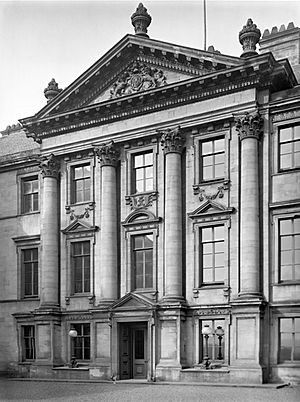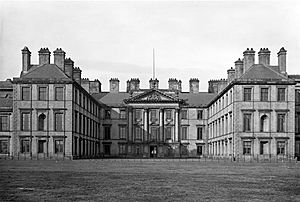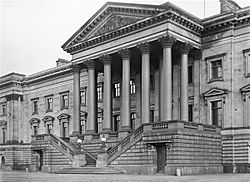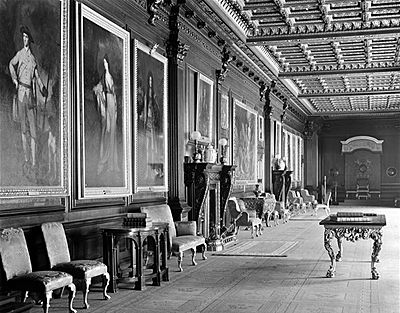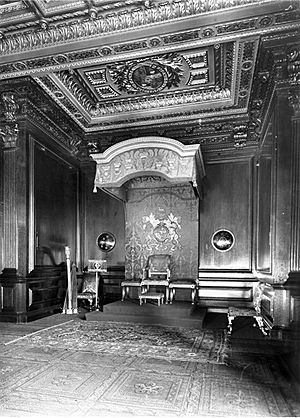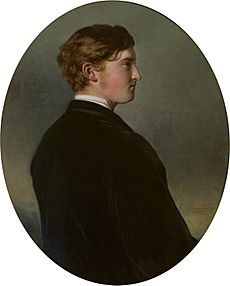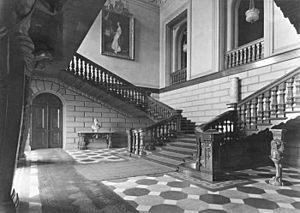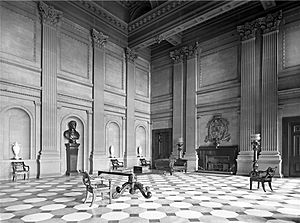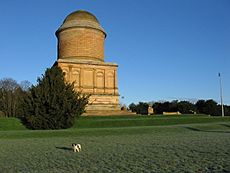Hamilton Palace facts for kids
Quick facts for kids Hamilton Palace |
|
|---|---|
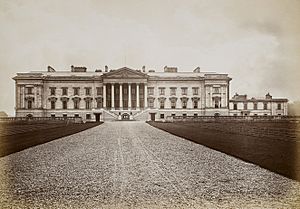
Hamilton Palace in 1870.
|
|
| General information | |
| Status | Demolished |
| Architectural style | Palladian, Neoclassical |
| Town or city | Hamilton, South Lanarkshire |
| Country | Scotland |
| Construction started | 14th century |
| Completed | 1701, with additions 1822-1828 |
| Demolished | 1921-1926 |
| Design and construction | |
| Architect | James Smith William Adam David Hamilton |
Hamilton Palace was a huge country house in Hamilton, South Lanarkshire, Scotland. It was the main home for the Dukes of Hamilton. The palace started as a small building in the 14th century. Over time, it grew much larger in the 17th and 19th centuries.
Many people thought it was one of the grandest houses in the British Isles. The palace was in the middle of a large area called the Low Parks. This area is now part of Strathclyde Country Park. A long, tree-lined road, over 3 miles (4.8 km) long, led to the palace. The Low Parks also had the Hamilton Mausoleum and the Netherton Cross. The High Parks, now Chatelherault Country Park, had the Chatelherault Hunting Lodge. Hamilton Palace was taken down between 1921 and 1926.
Contents
History of Hamilton Palace
Early Beginnings: 13th to 16th Centuries
The very first building at Hamilton Palace was a 13th-century tower house. It was known as 'The Orchard' or the 'Castle of Hamilton'. This was the home of the Hamilton family. Records show a castle there in 1445.
When the palace was taken down in the 1920s, workers found very thick walls. These walls were about 2.7 meters (9 feet) thick. This showed that the original building was a strong castle. In 1451, the local church was made into a special college church.
The castle was attacked several times between 1565 and 1579. It was damaged in 1570 during a war. This was because the Duke of Châtellerault supported Mary, Queen of Scots. The castle was damaged again in 1579. King James VI visited the castle for hunting in 1589. 'The Orchard' was rebuilt and made bigger in 1591. It was then called the 'Palace'.
Grand Designs: 17th and 18th Centuries
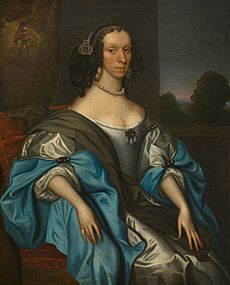
Anne, the 3rd Duchess of Hamilton, and her husband, William, started a huge rebuilding project. This happened from 1684 to 1701. They called it 'The Great Design'.
The palace was changed into a U-shaped house. It had an open courtyard facing south. The architect James Smith led this work. The south part of the palace was removed. The east and west parts were rebuilt as courtyard wings. The north part was updated inside and out.
The south front was rebuilt between 1693 and 1701. It was in the Palladian style. The main part of this new entrance was a large Corinthian porch. Inside the north front, the first floor had a very long room. This was called the Long Gallery, and it was 36.6 meters (120 feet) long. The west wing had the main apartments for the Duke.
In the 1730s, James, the 5th Duke, planned a new north front. Architect William Adam made detailed plans. But the Duke died early, and the plans were too expensive. However, Adam did oversee beautiful interior decorating in the east wing. More changes and additions were made over the next century. Land around the palace was bought to create large gardens.
A New Look: 19th Century Changes
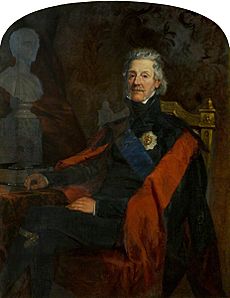
When Alexander became the 10th Duke in 1819, he started to make the north front even grander. He used the family's great wealth from their coal mines. The Duke wanted a magnificent home. It would show the family's importance and hold their large art collections. These collections included art and books his wife, Susan, inherited.
Between 1822 and 1828, the north front was made bigger by David Hamilton. This front was 265 feet (81 meters) long and 60 feet (18 meters) high. It had a huge porch with six 25-foot (7.6 meter) tall Corinthian columns.
New grand rooms were built, like the Egyptian Hall and the State Dining Room. These rooms held beautiful furniture. By the mid-1800s, the palace had one of Scotland's best private art collections. It included paintings by Peter Paul Rubens, Titian, and Anthony van Dyck.
The new palace was perfect for amazing parties. In 1831, Marie Thérèse of France, the daughter of King Louis XVI, visited. In 1843, a grand party was held for the future 11th Duke's wedding. Other important visitors included Victoria, Duchess of Kent (Queen Victoria's mother) in 1851. In 1860, the French empress Eugénie visited, and a big ball was held for her.
After his marriage in 1843, William, the 11th Duke, mostly lived abroad. His son, William, the 12th Duke, loved horse racing and sailing. He lived at Brodick Castle and Easton Park.
In January 1878, Edward, Prince of Wales, visited Hamilton Palace. He came with other important guests for hunting. Their visit ended with a grand ball. By the late 1800s, Hamilton Palace was very expensive to keep up. The family used it less often. The many building projects and art purchases had left the family with a lot of debt. The 12th Duke spent a lot on horses, increasing the debt.
To pay off his debts, the Duke had to sell many valuable items. In 1882, he sold the Beckford art collection and the Hamilton Library. The "Hamilton Palace Sale" happened in London. It included paintings by famous artists like Dürer and Rembrandt. It also had porcelain, furniture, and tapestries. The sale brought in a lot of money, but it meant many treasures left the palace.
Decline of Hamilton Palace
The 12th Duke died in 1895. He owned a lot of land but still had huge debts. His only child was his young daughter, Lady Mary Hamilton. So, the title of 13th Duke went to his distant cousin, Alfred Douglas-Hamilton. Alfred was a navy officer and not wealthy.
The 12th Duke's will allowed his trustees to sell parts of his estate. This was to pay off the debts. The will also said that if the trustees thought it was a good idea, they could empty and take down Hamilton Palace. The palace was not being used as a home anymore.
In 1889, the 12th Duke had allowed a coal company to mine coal under the Low Parks. The mining method was supposed to leave coal pillars to support the palace.
By the 1900s, very large country houses were no longer popular. They were too costly to maintain. Hamilton Palace had not been a family home for a long time. The 13th Duke thought it was not suitable for modern living. He preferred to live at the smaller Dungavel House.
In July 1914, the Duke and Duchess hosted King George V and Queen Mary at the palace. A grand party marked their visit. In June 1915, the Duke lent part of the palace to house soldiers and sailors injured in the First World War. In November 1915, the coal company was given permission to mine coal directly under the palace.
Sales and Demolition
In June 1919, the trustees asked the court for permission to sell the palace's contents and then tear down the building. They were told that the coal mining under the palace would damage it. The 13th Duke agreed to the demolition. Permission was given on June 12, 1919.
The magazine Country Life published articles about the palace. Many photos were taken before the sale and demolition. These photos are a valuable record of the palace.
The Hamilton Palace Collection was sold from November 4 to 7, 1919. This sale raised a lot of money. It included furniture, porcelain, silver, tapestries, jewelry, and paintings. Artists included van Dyck, Rubens, and Rembrandt. The rest of the palace's contents were sold at the palace itself. This included wood panels, furniture, and carpets.
In May 1920, Hamilton Town Council thought about buying the building. They wanted to turn it into public housing. In December, the Duke and Duchess gave 22 acres (8.9 hectares) of land at the front of the palace to the town. This land was for recreation.
The building was sold for demolition in October 1921. Work to take it down started in November 1921 and continued until 1926. The last parts were removed in 1932. In July 1922, Hamilton Town Council bought 750 acres (300 hectares) of the Hamilton Estate. This included the Hamilton Mausoleum and the stables.
Palace Grounds and Landmarks
Hamilton Palace was built near the River Clyde and the town of Hamilton. It was in the Low Parks. The palace was at the center of a huge garden. This garden had a main road lined with trees, over 3 miles (4.8 km) long. This garden design might have started in the late 1600s. It was later improved by William Adam. He added the Châtelherault hunting lodge to the south. This lodge had a great view over the Low Parks. The Low Parks had several other buildings.
Netherton Cross
The Netherton Cross is the oldest Christian symbol in Hamilton. It stood north of a medieval hill in the Low Parks. This area is now part of Strathclyde Country Park. The Netherton Cross is from the 10th or 11th century. It is a rare example of old stone carving from the Kingdom of Strathclyde. It is a free-standing cross made of red sandstone. It stands 2.1 meters (6.9 feet) tall. All four sides are decorated with pictures of people, animals, and patterns. In 1857, a railing was put around it to protect it.
The Duke and Duchess of Hamilton gave the cross to Hamilton Town Council in January 1920. In 1926, the Netherton Cross was moved. It was placed in front of Hamilton Old Parish Church. The cross is now protected by Historic Environment Scotland.
Hamilton Collegiate Church
The old church of Hamilton stood near the east side of Hamilton Palace. It became a college church in 1451. It was used as the local church and burial ground after the Reformation in 1560. When the Hamilton Old Parish Church opened in 1734, the old church was torn down. Only the east end and a side room remained. This room was the burial place for the ducal family. In 1852, the remains of 12 family members were moved to Hamilton Mausoleum. Then, the last parts of the old church were demolished.
Hamilton Mausoleum
The 10th Duke of Hamilton, Alexander, wanted to build a grand new burial place for his family. This was part of his plan to make Hamilton Palace even bigger. Architects David Hamilton and Henry Edmund Goodridge made designs. In 1848, the job went to David Bryce. He built the Hamilton Mausoleum on a new site. It was about 200 meters (650 feet) northeast of the palace.
Hamilton Palace Riding School
The Duke's Riding School was built from 1837 to 1842. It was designed by architect William Burn for the 10th Duke. It replaced the old stables at Hamilton Palace. In the 1920s and 1930s, the Riding School had a gym and boxing ring. It was a museum from 1983 to 1995. Now, it is the Low Parks Museum.
Hamilton Palace Today
The place where Hamilton Palace once stood is now a sports ground. It has a bowling pavilion, bowling greens, and a car park. Most of the palace's grounds are now part of Strathclyde Country Park. In 1974, during the park's construction, old underground rooms were found. These might have belonged to the palace. However, they were filled in with rubble instead of being explored.
The Hamilton Mausoleum still stands in Strathclyde Country Park. You can book tours at the nearby Hamilton Low Parks Museum. A black marble fireplace from the palace's Old State Drawing Room is on display. You can see it at the National Museum of Scotland in Edinburgh. The Dining Room is on display at the Museum of Fine Arts in Boston. Five panels of wrought iron railings from the palace grounds can be seen outside Hamilton College. The remains of the "Great Avenue" can still be seen. This avenue linked Hamilton Palace to the Chatelherault hunting lodge. From Chatelherault Country Park, you can still get a good idea of where the palace once stood.
Images for kids
-
Daniel in the Lions' Den by Peter Paul Rubens. This painting hung in the Long Gallery.
-
Portrait of James Hamilton, 2nd Marquess of Hamilton by Daniël Mijtens.
-
Portrait of James Hamilton, 6th Duke of Hamilton by Gavin Hamilton.
-
Assumption of the Virgin by Francesco Botticini.
-
The Circumcision by Luca Signorelli.


